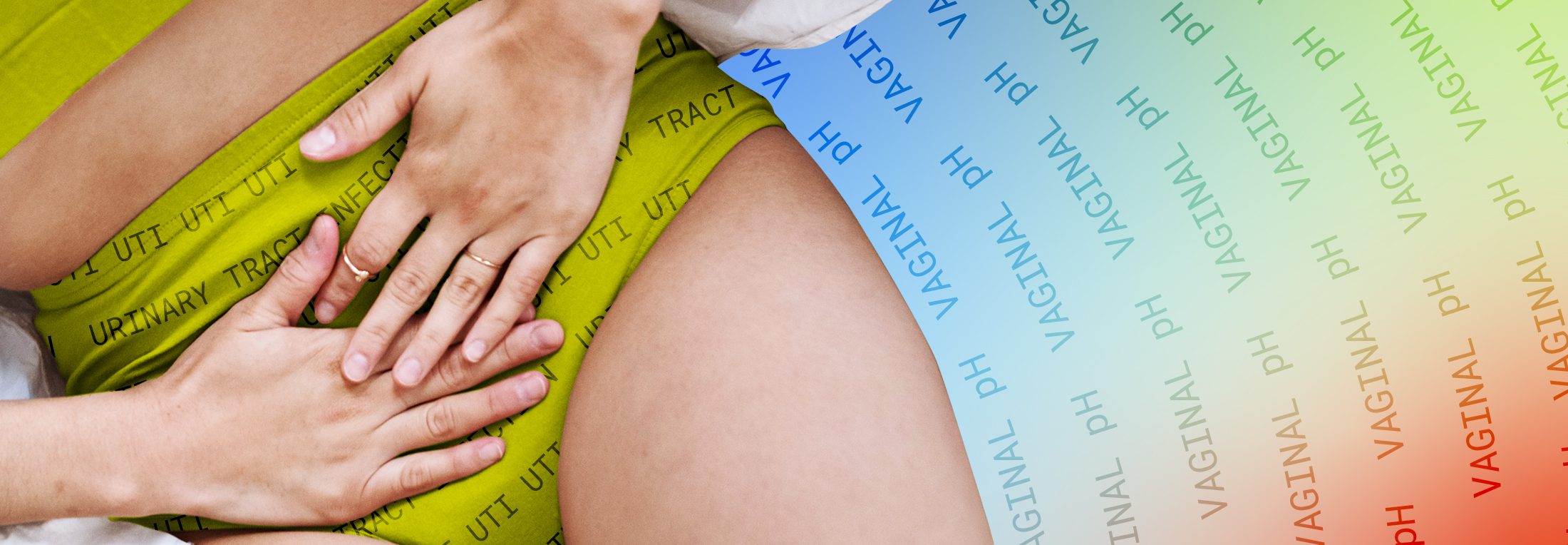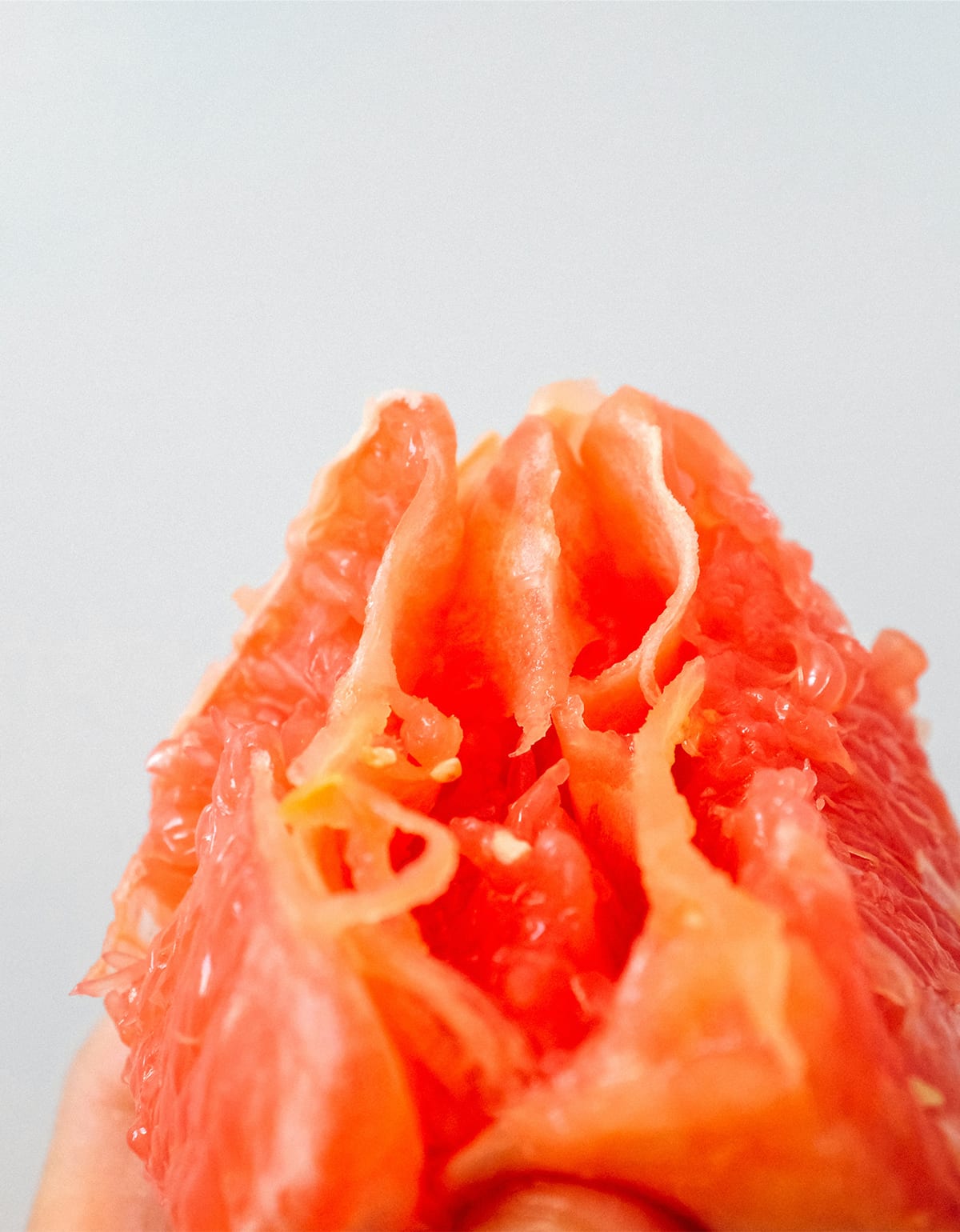Urinary Tract Infections (UTIs) can plague people for days or even weeks—and they’re extremely common. 1 in 2 vulva owners will get a UTI in their lifetime1, and about a quarter will develop recurrent infections within six months of their initial infection. 2 Even more of a bummer: each time a UTI returns, the chance of reoccurrence increases.
UTIs are one of the most common types of infections for vulva owners and elderly individuals, which begs the question: what other factors are at play—and is there anything you can do to stave a UTI off?
If you’ve ever guzzled down cranberry juice like there’s no tomorrow, then read on.
What is a UTI, really—and how does it happen?
You may first realize you have a UTI when you find yourself running to the bathroom every half hour without much to show for it—or, worse when you try to pee and encounter a painful burning sensation. It may be a pain in your abdomen or even a fever. At some point, you’ll ask yourself: how did I end up here?
Also called bladder infections or Cystitis, UTIs occur when bacteria enter the bladder through the urine tubes and begin to multiply. It can be hard to pinpoint the exact cause of a UTI because so many subtleties might lead to it, like dehydration or having sex (or not peeing after sex, which helps flush away any bacteria). However, in young, sexually active vulva owners, 80% of UTIs are caused by E. coli. 3 In other words, bacteria from your bowel find their way to the urinary tract.
New research 3 published in PLOS Pathogens found that there may be another contributor to recurring UTIs. A vaginal bacterium called Gardnerella vaginalis (the cause of Bacterial Vaginosis—a common infection in the vagina) causes E. coli hiding out in the bladder from previous UTIs to multiply. The result is (you guessed it) yet another UTI.
The authors postulate that part of why people with vaginas get recurring UTIs after sex is not just because of E. coli but because G. vaginalis lives in the vagina and can get nudged into the urinary tract during sex.
The vaginal microbiota and UTIs
Did you know your vagina has its very own little bacteria ecosystem? Known as the vaginal microbiota, it’s directly linked to your likelihood of getting a UTI: research published in Microbiology Spectrum found that any type of alteration in it is associated with increased risks. 4 It can even determine how successful a particular form of treatment may be.
So, you want a healthy microbiota—and, thankfully, specific species of bacteria can lead to better overall vaginal health. One such species is Lactobacillus, which may ring a bell as a touted yogurt ingredient, where it’s typically listed as Lactobacillus acidophilus.
What does Lactobacillus have to do with UTIs? A study published in Frontiers in Microbiology states that Lactobacillus dominates the vaginal microbiota and creates an acidic environment. 5 And, relevantly, the prevalence of lactobacillus and the environment it helps produce both defend against pathogens and opportunistic infections, like UTIs.
On the flip side, researchers also found that vaginal samples with decreased amounts of lactobacilli had increased vaginal colonization of E. coli. 4 The acidic environment that Lactobacillus creates plays a key role in vaginal health.

What role does vaginal pH play?
Let’s switch gears for a second and talk pH. If you need a refresher on your high school chem, pH is a measurement that captures how acidic or basic a substance is. A high number on the pH scale is basic (think bleach or ammonia), and a low pH is acidic (think battery acid or lemon juice). And importantly, neutral is plain water.
Good bacteria, like Lactobacillus, thrive in a more acidic environment, generally somewhere between 3.5 and 4.5. A normal vaginal pH is about 4.
Research 6 published in the American Journal of Obstetrics and Gynecology found that Lactobacillus grows best under a pH of 4.5. Lactobacillus, therefore, depends on an acidic pH, and an acidic pH depends on the growth of Lactobacillus.
In short: Lactobacilli produce lactic acid 7. Lactic acid is the cardinal acid in the vagina and is responsible for creating a healthy vaginal pH. A healthy vaginal pH may help protect against UTIs. Everything’s linked!
In fact, a small-scale study 8 examined lactic acid gel as a potential vaginal treatment for people with recurrent UTIs and found promising results. Lactic acid gel delayed recurrent UTIs in participants. This is good news for chronic antibiotic users with recurring UTIs who haven’t found relief in the standard options.
Can other infections tell us anything about the link between UTIs and vaginal pH balance? Bacterial vaginosis (BV) might. Women who have BV have a vaginal pH of 7 or higher, and BV is associated with an increased risk of UTIs. 9 Further, how acidic 10 someone’s urine is may predict how likely bacteria are to grow in the urinary tract.
Both pH and Lactobacillus are key elements in identifying a healthy vaginal microbiota that can best protect against pathogens and infection. If Lactobacillus and pH are two of the vagina’s strongest defense mechanisms, then how can we better support them?
How to support a healthy vaginal pH balance
If your pH is “off,” it doesn’t automatically imply that you have an infection. A myriad of factors can influence it, like menopause, antibiotics, semen (it’s alkaline!), and menstruation. Wondering how to fix your pH balance? There are plenty of things you can do to support a healthy vaginal pH:
1. Try Probiotics
Probiotics, including Lacobacilli, can replenish good bacteria and promote a healthy vaginal pH. They are recommended for UTIs11 and can be consumed through capsules or probiotic-rich foods.
2. Reconsider your period products
Tampons and pads made of synthetic materials can disrupt the vaginal pH balance. Consider switching to menstrual cups or menstrual discs, which are biologically inert and don’t interfere with pH levels.
3. Skip the Douche
Douching increases your vaginal pH level, creating a perfect environment for those not-so-friendly bacteria to throw a party.
4. Use Safe Sex Barriers
The age-old question, “Can a man throw off a woman’s pH balance?” Well, semen is alkaline. Thus, if you’re having penis-vagina sex, make sure to use a latex barrier. This will help keep your pH undisturbed.
5. Hold the Soap
Can soap cause a UTI? Soaps, fragrances, and powders can disrupt vaginal pH. Your vagina is self-cleaning, and you don’t need anything special to do the trick.
6. Wear Breathable Underwear
Tight, synthetic underwear traps moisture and creates a breeding ground for bacteria. Try cotton underwear instead (and go au naturale at night to give your vagina a breather).
All of which is to say, it’s time to put down the cranberry juice and try something new.

How Long does a UTI last?
The duration of a urinary tract infection (UTI) varies from person to person. If left untreated, it can last from a few days to a couple of weeks. However, symptoms usually improve with proper treatment within a day or two.
If you suspect a urinary tract infection, seek immediate medical attention and start treatment. Ignoring or delaying treatment can lead to complications like kidney infections that require more extensive treatment.
Can a UTI go away on its own? When to see a doctor
While some mild cases of urinary tract infections (UTIs) may resolve on their own, seeking medical attention and starting treatment as soon as possible is generally recommended. UTIs are caused by bacteria entering the urinary system. Without treatment, the infection can worsen.
Prompt treatment with antibiotics prescribed by your doctor can clear a UTI and prevent it from spreading. Drinking water or cranberry juice alone is not sufficient to effectively treat a urinary tract infection. Antibiotics are necessary to eliminate the bacteria causing the infection.
Delaying treatment or hoping that the infection will go away on its own can lead to complications and more severe symptoms.
About 1 in every 30 UTIs leads to kidney infections, which can cause way more severe pain than frequent urination. 12 Planned Parenthood recommends watching out for these symptoms: 13
- Frequent urination
- Pain or burning when you pee
- Bad-smelling or cloudy urine
- Blood or pus in your urine
- Soreness, pressure, or cramps in your lower belly, back, or sides
If the infection has spread to the kidneys, symptoms may increase in severity and lead to any of the following:
- Pain in your mid-back (to the right or left of the spine)
- Fever
- Chills
- Nausea
- Vomiting
It’s important to finish the full course of prescribed antibiotics, even if symptoms improve.
While you can find a slew of home remedies to treat UTIs online, if any of the above symptoms persist, it’s best to see a doctor.
Key takeaways
- UTIs are not fun, but they are extremely common!
- UTIs are most commonly the result of the bacteria E.coli.
- The vaginal microbiota plays an essential role in vaginal health and pH balance.
- Lactobacillus produces lactic acid, which is a key factor in determining how acidic the vagina is.
- Lactic acid gel could be an effective treatment for UTIs.
- A more acidic pH helps good bacteria thrive and banishes bad bacteria and pathogens.
- A less acidic, higher pH is associated with BV and other infections.
- Myriad factors can throw off pH balance, such as menstruation, semen, douching, and even your period products.
- UTIs left untreated can turn into kidney infections. Antibiotic treatment is the most common course of action.

This article is informational only and is not offered as medical advice, nor does it substitute for a consultation with your physician. If you have any gynecological/medical concerns or conditions, please consult your physician.
© 2023 The Flex Company. All Rights Reserved.
- Urinary tract infections (UTI). (n.d.). Better Health Channel – Better Health Channel. https://www.betterhealth.vic.gov.au/health/conditionsandtreatments/urinary-tract-infections-uti[↩]
- Vaginal bacteria can trigger recurrent UTIs, study shows. (2018, December 21). Washington University School of Medicine in St. Louis. https://medicine.wustl.edu/news/vaginal-bacteria-can-trigger-recurrent-utis-study-shows/[↩]
- Vaginal bacteria can trigger recurrent UTIs, study shows. (2018, December 21). Washington University School of Medicine in St. Louis. https://medicine.wustl.edu/news/vaginal-bacteria-can-trigger-recurrent-utis-study-shows/[↩][↩]
- Stapleton, A. E. (2016). The vaginal microbiota and urinary tract infection. Microbiology Spectrum, 4(6). https://doi.org/10.1128/microbiolspec.uti-0025-2016[↩][↩]
- Miller, E. A., Beasley, D. E., Dunn, R. R., & Archie, E. A. (2016). Lactobacilli dominance and vaginal pH: Why is the human vaginal microbiome unique? Frontiers in Microbiology, 7. https://doi.org/10.3389/fmicb.2016.01936[↩]
- Aroutcheva, A., Gariti, D., Simon, M., Shott, S., Faro, J., Simoes, J. A., Gurguis, A., & Faro, S. (2001). Defense factors of vaginal lactobacilli. American Journal of Obstetrics and Gynecology, 185(2), 375-379. https://doi.org/10.1067/mob.2001.115867[↩]
- O’Hanlon, D. E., Moench, T. R., & Cone, R. A. (2013). Vaginal pH and Microbicidal lactic acid when lactobacilli dominate the microbiota. PLoS ONE, 8(11), e80074. https://doi.org/10.1371/journal.pone.0080074[↩]
- Diebold, R., Schopf, B., Stammer, H., & Mendling, W. (2021). Vaginal treatment with lactic acid gel delays relapses in recurrent urinary tract infections: Results from an open, multicentre observational study. Archives of Gynecology and Obstetrics, 304(2), 409-417. https://doi.org/10.1007/s00404-021-06040-8[↩]
- HARMANLI, O. H., CHENG, G. Y., NYIRJESY, P., CHATWANI, A., & GAUGHAN, J. P. (2000). Urinary tract infections in women with bacterial vaginosis. Obstetrics & Gynecology, 95(5), 710-712. https://doi.org/10.1097/00006250-200005000-00015[↩]
- A person’s diet, acidity of urine may affect susceptibility to UTIs. (2021, February 9). The Source. https://source.wustl.edu/2015/06/a-persons-diet-acidity-of-urine-may-affect-susceptibility-to-utis/[↩]
- Falagas, M. E., Betsi, G. I., Tokas, T., & Athanasiou, S. (2006). Probiotics for prevention of recurrent urinary tract infections in women. Drugs, 66(9), 1253-1261. https://doi.org/10.2165/00003495-200666090-00007[↩]
- What is Kidney (Renal) Infection – Pyelonephritis? (n.d.). Urology Care Foundation. https://www.urologyhealth.org/urology-a-z/k/kidney-(renal)-infection-pyelonephritis[↩]
- What is a urinary tract infection? | Symptoms & causes. (n.d.). Planned Parenthood | Official Site. https://www.plannedparenthood.org/learn/health-and-wellness/urinary-tract-infections-utis[↩]




